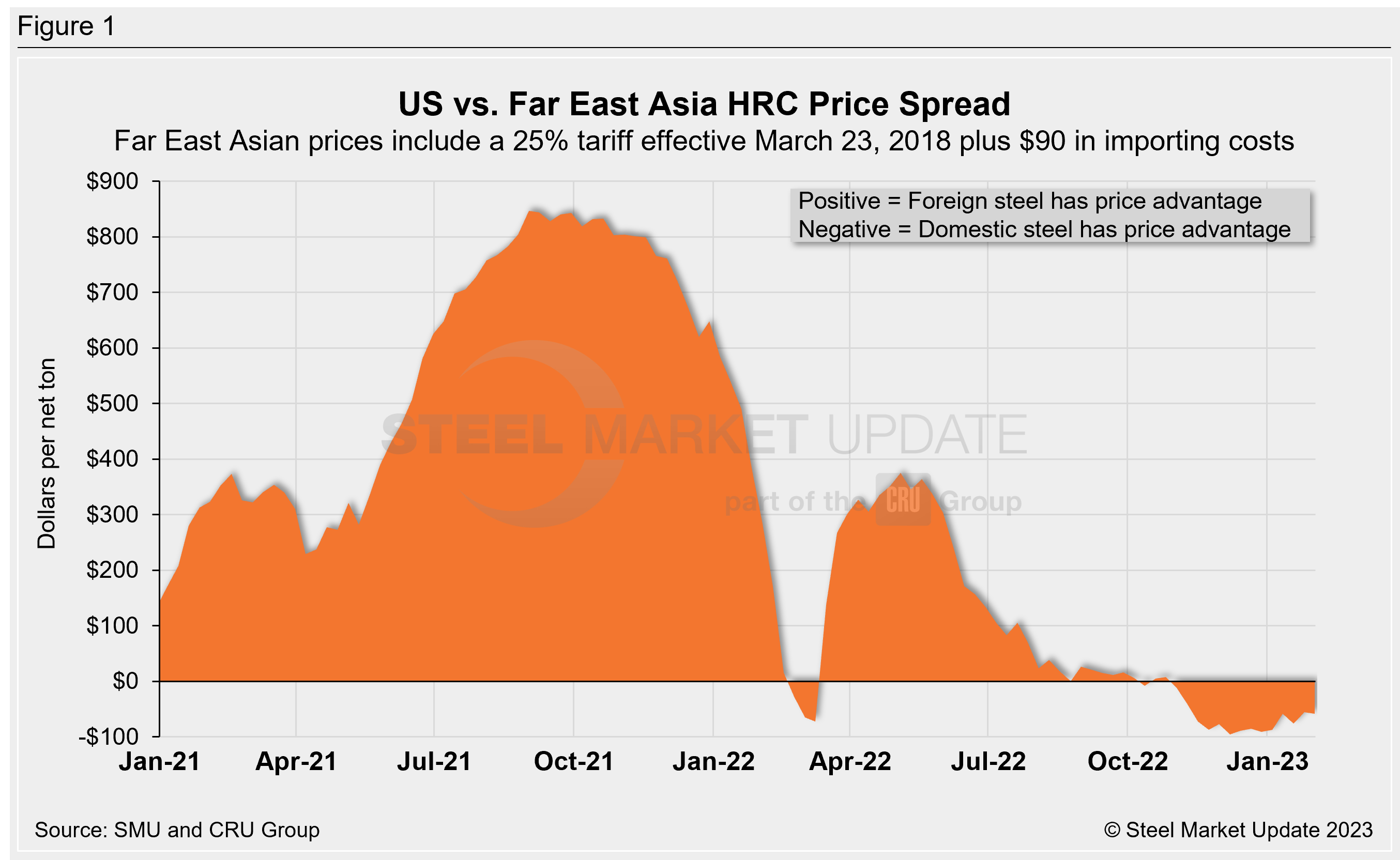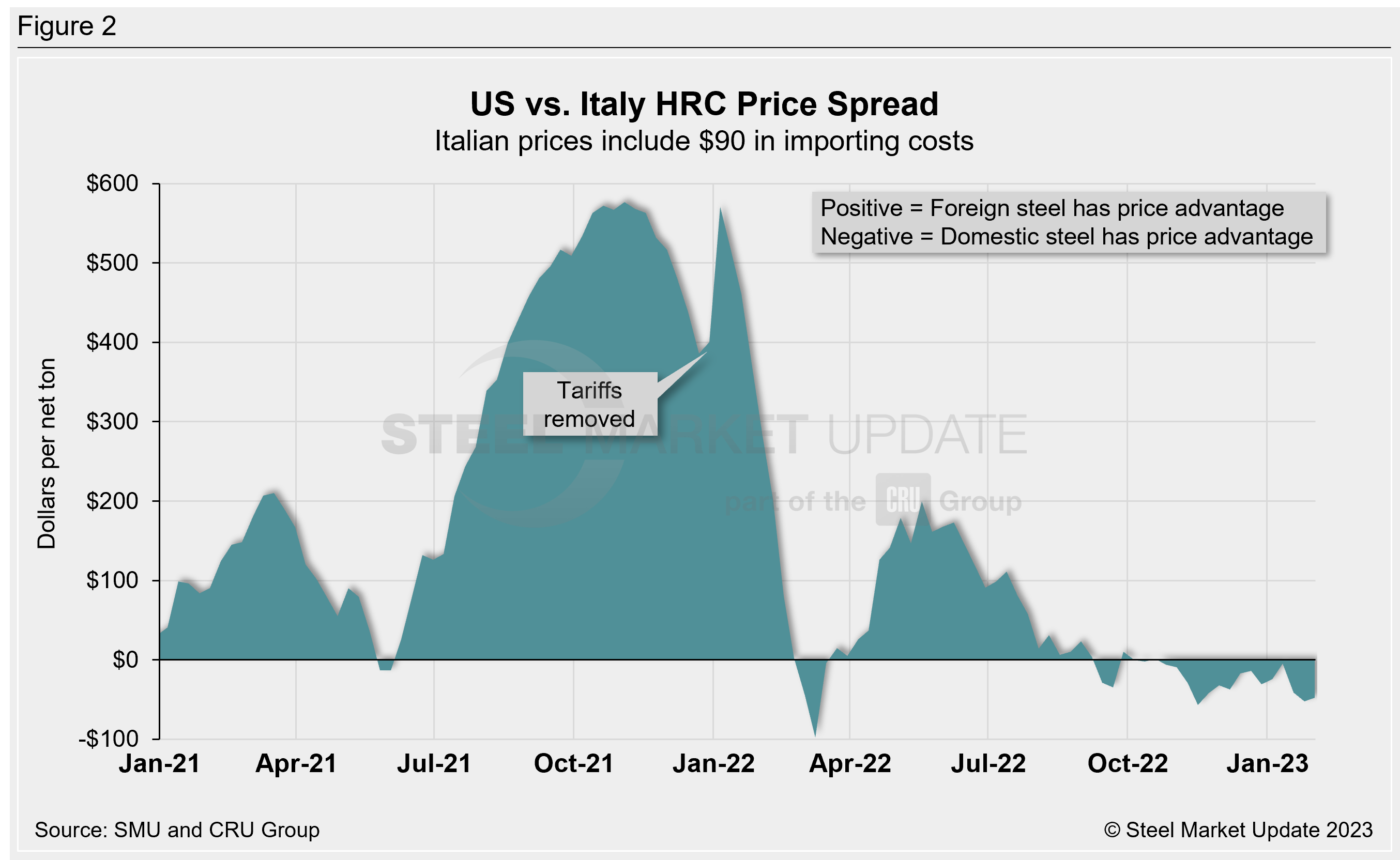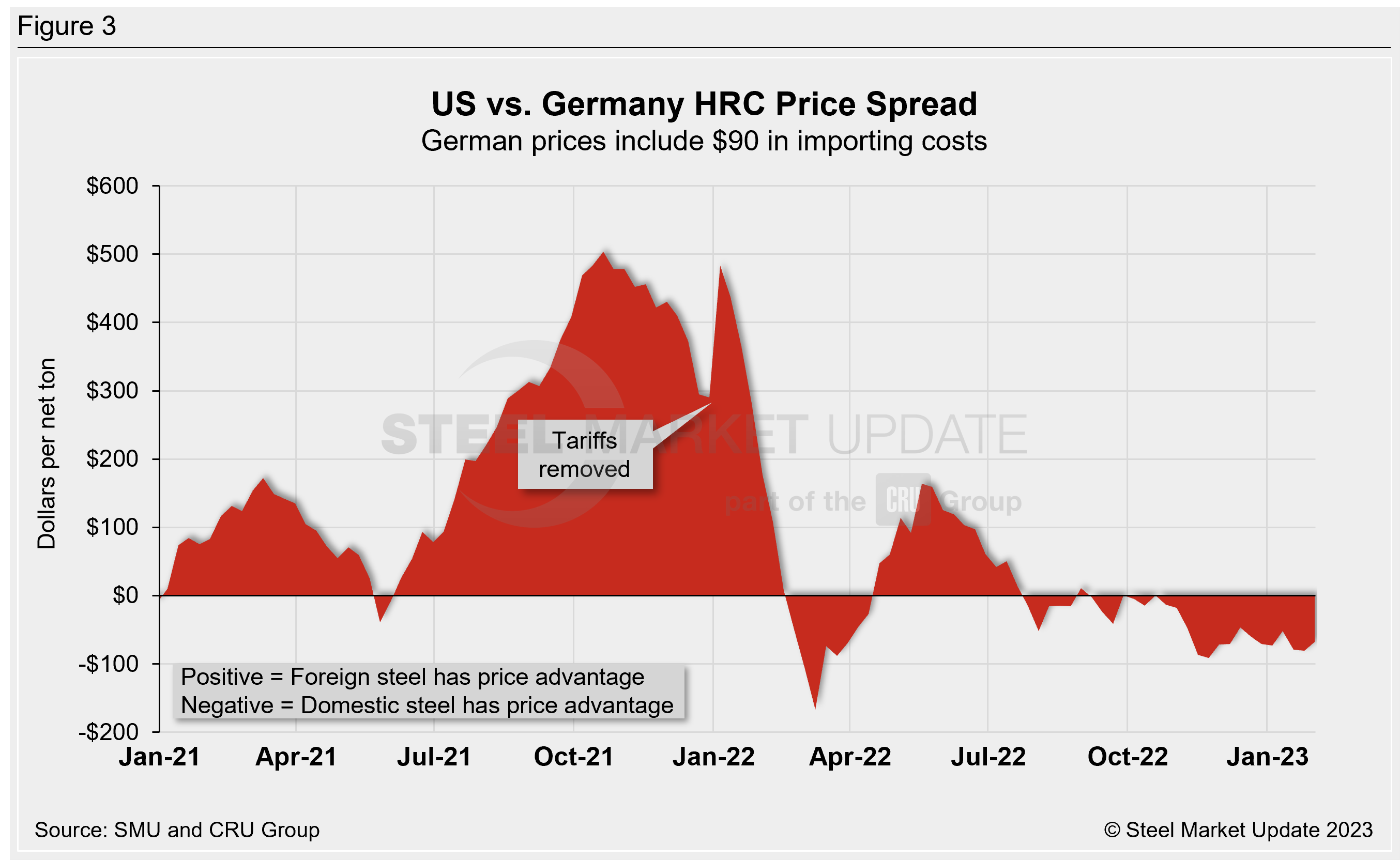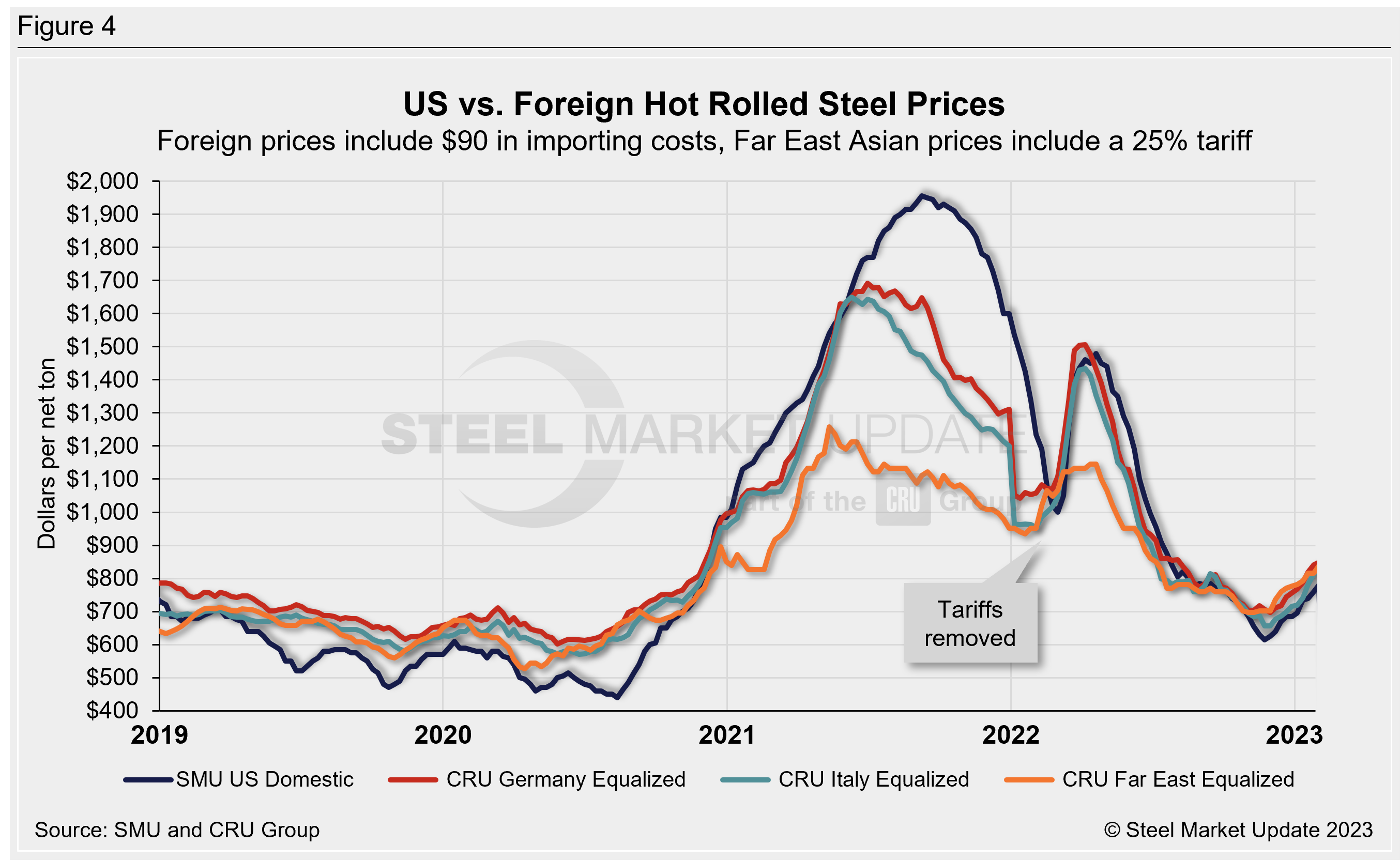Steel Mills
Domestic HRC’s Competitive Advantage Over Imports Slips
Written by David Schollaert
February 2, 2023
Domestic hot-rolled coil (HRC) kept its competitive price advantage run over imported steel – now 14 weeks running – though it did lose momentum week on week (WoW), according to Steel Market Update’s latest foreign vs. domestic price analysis.
![]() US HRC is approximately 7% cheaper than foreign prices this week, down slightly from 8% last week after consideration of freight costs, trader margins, and any applicable tariffs. US prices have been cheaper than foreign prices for all three regions we follow since the beginning of November. While margins have varied, HRC prices for all regions increased WoW, yet the average spread slipped from $63 per ton last week to $58 per ton this week as US prices also moved up.
US HRC is approximately 7% cheaper than foreign prices this week, down slightly from 8% last week after consideration of freight costs, trader margins, and any applicable tariffs. US prices have been cheaper than foreign prices for all three regions we follow since the beginning of November. While margins have varied, HRC prices for all regions increased WoW, yet the average spread slipped from $63 per ton last week to $58 per ton this week as US prices also moved up.
SMU uses the following calculation to identify the theoretical spread between foreign HRC prices (delivered to US ports) and domestic HRC prices (FOB domestic mills): Our analysis compares the SMU US HRC weekly index to the CRU HRC weekly indices for Germany, Italy, and Far East Asian ports. This is only a theoretical calculation because costs to import can vary greatly and often fluctuate, which influences the true market spread.
In consideration of freight costs, handling, and trader margin, we add $90 per ton to all foreign prices to provide an approximate CIF US ports price that can be compared against the SMU domestic HRC price. Buyers should use our $90-per-ton figure as a benchmark, adjusting it as necessary based on their own shipping and handling costs. If you have experience importing foreign steel and want to share your thoughts on these costs, we welcome your insight and comments: david@steelmarketupdate.com.
Far East Asian Hot-Rolled Coil (East and Southeast Ports)
As of Thursday, Feb. 2, the CRU Far East Asian HRC price moved higher, reaching $599 per net ton ($60 per metric ton), and up $45 from levels one month prior. Adding a 25% tariff, and $90 per ton in estimated import costs, the delivered price of Far East Asian HRC to the US is $838 per ton. The latest SMU hot-rolled average is $780 per ton, up $20 per ton from our previous price update, and up $85 per ton compared to our price one month ago.
Therefore, US-produced HRC is now $58 per ton cheaper than steel imported from Far East Asia. This is up slightly from a spread of $56 per ton one week prior. One month ago we saw a spread of $87 per ton, still among one of the largest price appeals that domestic HRC has had over Far East Asian HRC since September 2020. Prior to October, Far East Asian prices had held the advantage since mid-March (the differential peaked at $375 per ton in May). The widest price advantage recorded for Far East Asian prices was nearly 16 months ago, at $847 per ton in September 2021.

Italian Hot-Rolled Coil
Italian HRC prices increased $16 per ton WoW to $738 per net ton ($814 per metric ton) this week, and $110 per ton higher month on month (MoM). After adding import costs, the delivered price of Italian HRC is approximately $828 per ton.
Domestic HRC is now theoretically $48 per ton cheaper than imported Italian HRC, down from a spread of $52 per ton last week. One month ago we saw a spread of $24 per ton, favoring domestic prices. In mid-November we saw a spread of $57 per ton, the largest margin in favor of US prices recorded since last March. Domestic steel has held this price advantage since late October. Before the removal of the 25% Section 232 tariff, the spread just 15 months ago reached $577 per ton in November, the largest in SMU’s data history.

German Hot-Rolled Coil
CRU’s latest German HRC price increased just $7 per ton WoW to $758 per net ton ($836 per metric ton), up $80 per ton MoM. After adding import costs, the delivered price of German HRC is roughly $848 per ton.
Accordingly, domestic HRC is now theoretically $68 per ton cheaper than imported German HRC, down from a spread of $81 per ton one week prior. Four weeks ago, prices between these regions were $73 per ton apart (with US prices holding the advantage). Domestic HRC has held this price advantage for all but three weeks since late July and on a 15-week run. German HRC held the price advantage for the three months prior to that, having reached a 2022 high of $164 per ton in May. Before the removal of the 25% tariff, the October 2021 spread of $504 per ton was the widest in SMU’s data history.

Figure 4 compares all four price indices and highlights the effective date of the tariffs. Foreign prices are referred to as “equalized,” meaning they have been adjusted to include importing costs (and tariffs in some cases) for a like-for-like comparison against the US price.

Notes: Freight is an important part of the final determination on whether to import foreign steel or buy from a domestic mill supplier. Domestic prices are referenced as FOB the producing mill, while foreign prices are CIF the port (Houston, NOLA, Savannah, Los Angeles, Camden, etc.). Inland freight, from either a domestic mill or from the port, can dramatically impact the competitiveness of both domestic and foreign steel. When considering lead times, a buyer must take into consideration the momentum of pricing both domestically and in the world markets. In most circumstances, domestic steel will deliver faster than foreign steel ordered on the same day.
Effective Jan. 1, 2022, the traditional Section 232 tariff no longer applies to most imports from the European Union. it has been replaced by a tariff rate quota (TRQ). Therefore, the German and Italian price comparisons in this analysis no longer include a 25% tariff. SMU still includes the 25% Section 232 tariff on foreign prices from other countries. We do not include any antidumping (AD) or countervailing duties (CVD) in this analysis.
By David Schollaert, david@steelmarketupdate.com

David Schollaert
Read more from David SchollaertLatest in Steel Mills

Cliffs unveils new hydrogen-powered stainless line in Ohio
CEO Lourenco Goncalves, flanked by state leaders and union reps, touted the project as proof that US manufacturing is not only alive, but also advancing.

Cliffs idles Steelton, Riverdale, and Conshohocken operations
Cliffs has idled facilities in Riverdale, Ill., and Conshohocken and Steelton, Pa.

Radius loss narrows, volumes climb in ‘healthy’ West Coast market
Stronger steel demand in the Western US, rising scrap flows, and improved rolling mill utilization drove sequential gains for Portland, Ore.-based Radius Recycling.

AISI: Raw steel production backs off multi-year high
US raw steel output edged lower last week after hitting a multi-year high in mid-June, according to the American Iron and Steel Institute (AISI).

Private equity firm Atlas Holdings to acquire Evraz North America
Atlas Holdings said it has signed a definitive agreement to acquire Evraz North America (Evraz NA). The Greenwich, Conn.-based private equity firm said it expects the deal for the Chicago-based steelmaker to close in the second quarter of 2025 subject to various closing condition.
